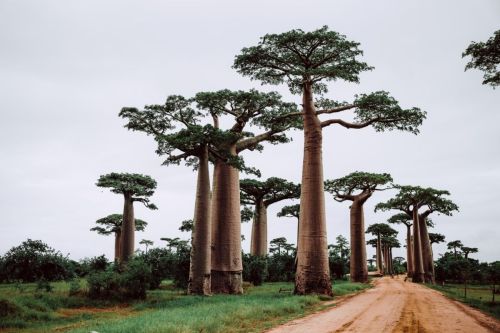The name of the desert is derived from Arabic, where the word ṣaḥārā means deserts (plural feminine).
For at least several thousand years, the Sahara was lush green and teeming with life. Its entire surface was covered with savannahs, it was a grassy and forested terrain.
The ancient Egyptians were able to cultivate the land, raise animals, and live in abundance. A few thousand years ago, the climate in the Sahara changed, the monsoon clouds moved south, the rains stopped and desert began to appear.
Today the Sahara is sand dunes and hellish heat. There are many interesting facts associated with the place, which we list below.
To the north it is bounded by the Atlas Mountains and the Mediterranean coast. In the south, it borders a geographical region called the Sahel.
The desert covers 31% of Africa and 8% of the Earth's land area. Comparing the Sahara to countries, its area is almost identical to that of the United States of America.
These are: Algeria, Morocco, Tunisia, Libya, Egypt, Western Sahara, Mauritania, Mali, Niger, Chad, Sudan.
The Sahara contains all known types of deserts, except the ice desert, which is the Antarctic.
This landscape is dominated by bare rocks, boulders, and sometimes gravel. The sand was blasted out of them by a process of deflation (erosion by wind).
Ergs are mostly covered with dunes, but there are also some where dunes are absent. Many of the dunes found in the Sahara are more than 180 meters high.
The highest dunes in the Sahara are found in a desert with the sonorous name Isaouane-n-Tifernine in Algeria. The height of the dunes ranges from 420 to 465 meters (1377 to 1525 feet) . The dunes of Isaouane-n-Tifernine are considered the fifth highest dunes on earth.
Since it does not rain there, clouds do not form, the sky is clear. The absence of clouds also results in large daily temperature amplitudes; when the sun sets, there is nothing to keep the heat near the surface.
During the day, average temperatures are 30-35 °C (86-95 °F). At night, the temperature drops to 10-20 °C (50-68 °F), and occasionally it can fall below 0 °C (32 °F).
These are largely relict, non-renewable bodies of water that date back to times when the Sahara had a much wetter climate.
In the central part of Algeria, there is a natural area about 160 kilometers long that contains a string of small oases. Several towns and numerous villages have been established there.
A record temperature of 83.5 °C (182,3 °F) was measured in the city of Port Sudan. Average surface temperatures often exceed 80 °C (176 °F).
Among plants, palms, thorny shrubs, grasses, and various types of succulents are most common. The most common animals are lizards, snakes, scorpions, and also small mammals such as the Rock hyrax and the Fennec fox - one of the smallest representatives of the canines.
About 2.5 million people live in the desert, mainly in Algeria, Morocco and Mauritania.
The volcano is located in Chad, in the volcanic massif Tibesti, and has a diameter of about 65 kilometers.

The last eruptions of Emi Koussi occurred between 2.4 and 1.3 million years ago.
Most of them are salt lakes. Why are these lakes salty? When water is exposed to the surface in an arid and dry environment, it becomes salty because of the high evaporation rate. Some lakes in the Sahara evaporate about 6 meters of water per year.
A unique geological form is the Ounianga lakes in northeastern Chad. These lakes were formed thanks to the trade winds that gave them a unique shape. They are punctuated by sand dunes and are located on the site of a former single large lake that was there from about 15,000 to 5,500 years ago.
All 18 lakes of Ounianga are fed by water accumulated in an underground aquifer during a humid period in the history of the Sahara thousands of years ago.
Its water is used by about 30 million people. It is the largest non-tidal lake in Central Africa. In the last 50 years, the lake has lost most of its water due to climate change and human activities.
The current desert phase will last for the next 15,000 years, after which there will probably be another 20,000 year period when the savannah will return to these areas.
Changes in the angle of the Earth's axis affect the position of the North African monsoon, which is capable of reviving the Saharan region.
The Tashwinat mummy was found in a cave of the archaeological site of Uan Muhuggiag in Libya. It is the mummified body of a child about threeyears old, buried there between 5,400 and 5,600 years ago. The mummy was wrapped in goatskin and its interior was filled with a mixture of herbs.
According to archaeological findings, the beginning of the Egyptian state dates back to 3000 BC, so this burial predates ancient Egypt by about half a millennium.
Wall paintings depicting people and animals were also found in the cave.
Among the 15,000 drawings identified so far are large wild animals (antelopes and crocodiles), herds of cattle, and humans. This proves that 10-12 thousand years ago the Sahara was a savannah inhabited by numerous animals.
The lack of precipitation is more noticeable in the eastern Sahara, where the climate is more continental.
About 17% of the total area of the desert recieves an average of 5 mm (0.2 in) or less annual average rainfall.
Many rivers in the Sahara are periodic, episodic in nature. They flow only at certain times of the year when heavy rainfall occurs in their basins.
The most numerous tribe are the Tauregs. Their profession is barter trade with the inhabitants of the oases. The nomads supply milk, meat and pack animals in exchange for grain, dates, coffee, salt, weapons and ammunition.
Caravans move by camels, mules and donkeys along well-trodden routes.













